Sony XAV-622, XAV-62BT Operating Instruction
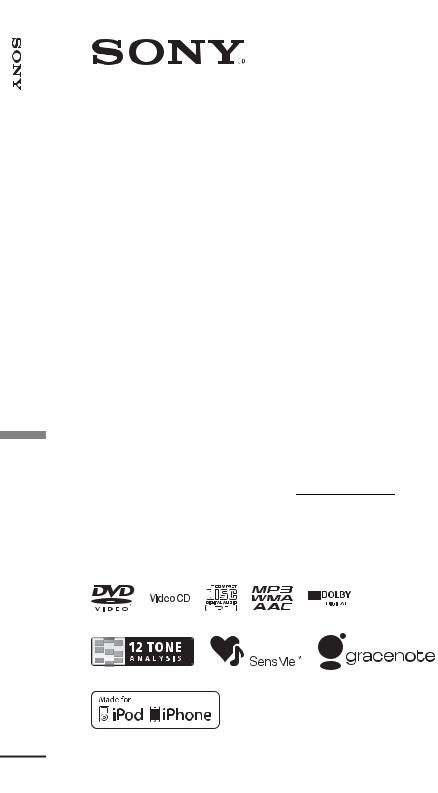
4-263-232-13(1)
Center AV
AV Center
Operating Instructions |
|
|
US |
|
Mode d’emploi |
|
|
|
|
|
|
|
FR |
|
Manual de instrucciones |
|
|
||
|
ES |
|||
Owner’s Record
The model and serial numbers are located on the bottom of the unit.
Record the numbers in the space provided below.
Refer to these numbers whenever you call upon your Sony dealer regarding this product.
Model No. |
|
Serial No. |
XAV-62BT
XAV-622
©2011 Sony Corporation

Be sure to install this unit in the dashboard of the car for safety. For installation and connections, refer to the supplied “Installation/Connections” guide.
About this manual
•This manual contains instructions for XAV62BT and XAV-622.
•XAV-62BT is the model representatively used for illustration purposes.
•Bluetooth functions and descriptions apply only to XAV-62BT.
Warning
To prevent fire or shock hazard, do not expose the unit to rain or moisture.
To avoid electrical shock, do not open the cabinet. Refer servicing to qualified personnel only.
CAUTION
The use of optical instruments with this product will increase eye hazard. As the laser beam used in this CD/DVD player is harmful to eyes, do not attempt to disassemble the cabinet. Refer servicing to qualified personnel only.
FOR UNITED STATES CUSTOMERS. NOT APPLICABLE IN CANADA, INCLUDING IN THE PROVINCE OF QUEBEC.
POUR LES CONSOMMATEURS AUX ÉTATS-UNIS. NON APPLICABLE AU CANADA,Y COMPRIS LA PROVINCE DE QUÉBEC.
This equipment has been tested and found to comply with the limits for a Class B digital device, pursuant to Part 15 of the FCC Rules. These limits are designed to provide reasonable protection against harmful interference in a residential installation. This equipment generates, uses, and can radiate radio frequency energy and, if not installed and used in accordance with the instructions, may cause harmful interference to radio communications. However, there is no guarantee that interference will not occur in a particular installation. If this equipment does cause harmful interference to radio or television reception, which can be determined by turning the equipment off and on, the user is encouraged to try to correct the interference by one or more of the following measures:
–Reorient or relocate the receiving antenna.
–Increase the separation between the equipment and receiver.
–Connect the equipment into an outlet on a circuit different from that to which the receiver is connected.
–Consult the dealer or an experienced radio/TV technician for help.
You are cautioned that any changes or modifications not expressly approved in this manual could void your authority to operate this equipment.
2

Warning if your car’s ignition has no ACC position
Be sure to set the Auto Off function (page 49).
The unit will turn off automatically in the set time when no source is selected, which prevents battery drainage.
If you do not set the Auto Off function, press and hold (SOURCE/OFF) until the display disappears each time you turn the ignition off.
To cancel the demonstration (Demo) display, see page 53.
The following applies only to XAV-62BT:
This device complies with Part 15 of the FCC Rules and RSS-Gen of IC Rules. Operation is subject to the following two conditions: (1) this device may not cause harmful interference, and
(2) this device must accept any interference received, including interference that may cause undesired operation of the device.
This transmitter must not be co-located or operated in conjunction with any other antenna or transmitter.
This equipment complies with FCC/IC radiation exposure limits set forth for an uncontrolled environment and meets the FCC radio frequency (RF) Exposure Guidelines in Supplement C to OET65 and RSS-102 of the IC radio frequency (RF) Exposure rules. This equipment has very low levels of RF energy that it deemed to comply without maximum permissive exposure evaluation (MPE). But it is desirable that it should be installed and operated keeping the radiator at least 20 cm or more away from person’s body (excluding extremities: hands, wrists, feet and ankles).
3

Table of Contents
Notes on safety . . . . . . . . . . . . . . . . . . . . . . . . . .8
Notes on installation. . . . . . . . . . . . . . . . . . . . . .8
Copyrights . . . . . . . . . . . . . . . . . . . . . . . . . . . . .8
Notes on Bluetooth (XAV-62BT only) . . . . . .10
Playable discs and symbols used in these Operating Instructions . . . . . . . . . . . . . . . . . . .11
Location and function of controls/
terminals. . . . . . . . . . . . . . . . . . . . . . . . . . . . . .12 Main unit . . . . . . . . . . . . . . . . . . . . . . . . . . .12
Getting Started
Resetting the unit . . . . . . . . . . . . . . . . . . . . . . .14
Performing initial settings . . . . . . . . . . . . . . . .14
Radio
Listening to the radio . . . . . . . . . . . . . . . . . . . .15 Reception controls . . . . . . . . . . . . . . . . . . . .15 Reception indications . . . . . . . . . . . . . . . . .16
Storing and receiving stations . . . . . . . . . . . . .16 Storing automatically — BTM . . . . . . . . . .16 Storing manually . . . . . . . . . . . . . . . . . . . . .16 Receiving stored stations. . . . . . . . . . . . . . .16
RDS . . . . . . . . . . . . . . . . . . . . . . . . . . . . . . . . .16
Overview . . . . . . . . . . . . . . . . . . . . . . . . . . .16
Selecting PTY . . . . . . . . . . . . . . . . . . . . . . .17
Setting CT . . . . . . . . . . . . . . . . . . . . . . . . . .17
Discs
Playing discs . . . . . . . . . . . . . . . . . . . . . . . . . . 17 Playback controls . . . . . . . . . . . . . . . . . . . . 18 Playback indications . . . . . . . . . . . . . . . . . . 19
Using PBC (playback control) functions. . . . . 20
Configuring audio settings . . . . . . . . . . . . . . . 20 Changing the audio language/format . . . . . 20 Changing the audio channel . . . . . . . . . . . . 21 Adjusting the audio output level
— Dolby D level. . . . . . . . . . . . . . . . . . . . . 21
Locking discs — Parental control . . . . . . . . . . 21 Activating parental control . . . . . . . . . . . . . 21 Changing the area and its movie rating
level. . . . . . . . . . . . . . . . . . . . . . . . . . . . . . . 22
Repeat and shuffle play . . . . . . . . . . . . . . . . . . 22
Direct search play . . . . . . . . . . . . . . . . . . . . . . 23
USB Device Operations
Playing from a USB device . . . . . . . . . . . . . . . 24
Repeat and shuffle play . . . . . . . . . . . . . . . . . . 24
Enjoying music according to your mood
— SensMe™ . . . . . . . . . . . . . . . . . . . . . . . . . . 25 Before using the SensMe™ function . . . . . 25 Installing “SensMe™ Setup” and “Content Transfer” on your computer . . . . . . . . . . . . 25 Registering a USB device using “SensMe™ Setup” . . . . . . . . . . . . . . . . . . . . . . . . . . . . . 26 Transferring tracks to the USB device using “Content Transfer” . . . . . . . . . . . . . . . . . . . 26 Playing tracks in channels
— SensMe™ channels . . . . . . . . . . . . . . . . 26 Playing tracks in mood maps
— SensMe™ mood. . . . . . . . . . . . . . . . . . . 28
4

iPod Operations
Playing an iPod . . . . . . . . . . . . . . . . . . . . . . . . 29
Setting the play mode . . . . . . . . . . . . . . . . . . . 29
Repeat and shuffle play . . . . . . . . . . . . . . . . . . 30
Operating an iPod directly
— Passenger control . . . . . . . . . . . . . . . . . . . . 30
Useful Functions
Listing up tracks/images/video files
— List . . . . . . . . . . . . . . . . . . . . . . . . . . . . . . . 31 Selecting a track/image/video file. . . . . . . . 31 Selecting a file type. . . . . . . . . . . . . . . . . . . 31
Searching for a track by listening to track passages — ZAPPIN™ . . . . . . . . . . . . . . . . . . 31
Using Gesture Command . . . . . . . . . . . . . . . . 32
Handsfree Calling and Audio Streaming — Bluetooth (XAV-62BT only)
Before using the Bluetooth function. . . . . . . . 32 Basic procedure of the Bluetooth
function . . . . . . . . . . . . . . . . . . . . . . . . . . . 32 Bluetooth status indications . . . . . . . . . . . . 33 Installing the microphone
(XAV-62BT only) . . . . . . . . . . . . . . . . . . . 33
Pairing. . . . . . . . . . . . . . . . . . . . . . . . . . . . . . . 33 Searching from this unit . . . . . . . . . . . . . . . 33 Searching from the Bluetooth device . . . . . 34
Connecting . . . . . . . . . . . . . . . . . . . . . . . . . . . 35
Handsfree calling . . . . . . . . . . . . . . . . . . . . . . 35 Making calls . . . . . . . . . . . . . . . . . . . . . . . . 35 Receiving calls . . . . . . . . . . . . . . . . . . . . . . 37 Operations during a call . . . . . . . . . . . . . . . 37
Phonebook management . . . . . . . . . . . . . . . . . 38 Storing phonebook data . . . . . . . . . . . . . . . 38 Browsing a phonebook in a cellular
phone . . . . . . . . . . . . . . . . . . . . . . . . . . . . . 39 Deleting phonebook data . . . . . . . . . . . . . . 39 Editing a contact. . . . . . . . . . . . . . . . . . . . . 39
Call data management. . . . . . . . . . . . . . . . . . . 40 Call history . . . . . . . . . . . . . . . . . . . . . . . . . 40 Preset dial . . . . . . . . . . . . . . . . . . . . . . . . . . 40 Locking personal information . . . . . . . . . . 41
Audio streaming . . . . . . . . . . . . . . . . . . . . . . . 41 Listening to a Bluetooth device via
this unit. . . . . . . . . . . . . . . . . . . . . . . . . . . . 41 Operating a Bluetooth device with
this unit. . . . . . . . . . . . . . . . . . . . . . . . . . . . 41
Bluetooth settings . . . . . . . . . . . . . . . . . . . . . . 42
continue to next page t
5

Sound Adjustment
Selecting the sound quality — EQ7 . . . . . . . . .43 Customizing the equalizer curve
— EQ7 Tune . . . . . . . . . . . . . . . . . . . . . . . .43
Adjusting the sound characteristics . . . . . . . . .43
Optimizing sound for the listening position
— Intelligent Time Alignment. . . . . . . . . . . . .44 Calibrating the listening position
— Intelligent Time Alignment Tune . . . . . .44
Speaker configuration and volume setup . . . . .45 Creating a virtual center speaker
— CSO . . . . . . . . . . . . . . . . . . . . . . . . . . . .45 Using rear speakers like subwoofers
— Rear Bass Enhancer . . . . . . . . . . . . . . . .45 Adjusting the speaker volume . . . . . . . . . . .45
Monitor Adjustment
Touch panel calibration . . . . . . . . . . . . . . . . . .46
Setting the background screen . . . . . . . . . . . . .46
Adjusting the picture — Picture EQ . . . . . . . .46 Customizing the picture. . . . . . . . . . . . . . . .47
Selecting the aspect ratio . . . . . . . . . . . . . . . . .47
Settings
Basic setting operation . . . . . . . . . . . . . . . . . . .48
General settings . . . . . . . . . . . . . . . . . . . . . . . .49
Sound settings . . . . . . . . . . . . . . . . . . . . . . . . .51
Screen settings . . . . . . . . . . . . . . . . . . . . . . . . .53
DVD and other playback settings. . . . . . . . . . .54
Setting the security code . . . . . . . . . . . . . . . . .56
Setting the clock . . . . . . . . . . . . . . . . . . . . . . . .56
Using Optional Equipment
Auxiliary audio/video equipment . . . . . . . . . . 57
RM-X170 Remote Commander . . . . . . . . . . . 57
Rear view camera . . . . . . . . . . . . . . . . . . . . . . 59 Rear view camera settings . . . . . . . . . . . . . 59
Additional Information
Precautions . . . . . . . . . . . . . . . . . . . . . . . . . . . 60 Notes on LCD panel . . . . . . . . . . . . . . . . . . 60 Notes on discs . . . . . . . . . . . . . . . . . . . . . . . 60 Playback order of MP3/WMA/AAC/JPEG/ Xvid/MPEG-4 files . . . . . . . . . . . . . . . . . . . 61 About MP3 files . . . . . . . . . . . . . . . . . . . . . 61 About WMA files . . . . . . . . . . . . . . . . . . . . 61 About AAC files . . . . . . . . . . . . . . . . . . . . . 61 About JPEG files . . . . . . . . . . . . . . . . . . . . 61 About MPEG-4 files . . . . . . . . . . . . . . . . . . 62 About iPod . . . . . . . . . . . . . . . . . . . . . . . . . 62 About Bluetooth function . . . . . . . . . . . . . . 62
Maintenance . . . . . . . . . . . . . . . . . . . . . . . . . . 63
Specifications . . . . . . . . . . . . . . . . . . . . . . . . . 64
Troubleshooting. . . . . . . . . . . . . . . . . . . . . . . . 66
Error displays/messages . . . . . . . . . . . . . . . 69
Language code/area code list. . . . . . . . . . . . . . 71
Index . . . . . . . . . . . . . . . . . . . . . . . . . . . . . . . . 72
6

Support site
If you have any questions or for the latest support information on this product, please visit the web site below:
http://esupport.sony.com
http://www.sony.com/mobileAV
Provides information on:
•Models and manufacturers of compatible digital audio players
•Models and manufacturers of compatible cellular phones and the FAQ about Bluetooth function (for XAV-62BT only)
7
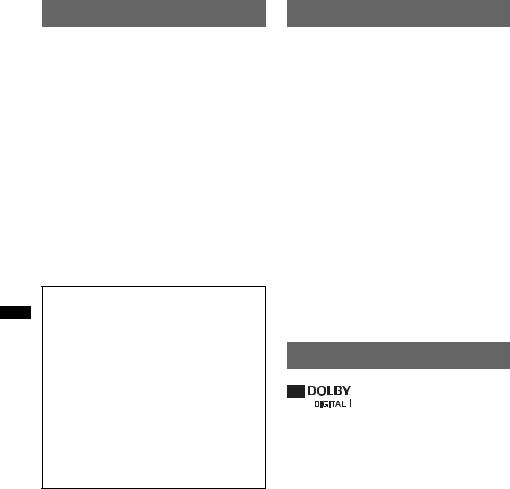
Notes on safety
•Comply with your local traffic rules, laws and regulations.
•While driving
–Do not watch or operate the unit, as it may lead to distraction and cause an accident. Park your car in a safe place to watch or operate the unit.
–Do not use the setup feature or any other function which could divert your attention from the road.
–When backing up your car, be sure to look back and watch the surroundings carefully for your safety, even if the rear view camera is connected. Do not depend on the rear view camera exclusively.
•While operating
–Do not insert your hands, fingers or foreign object into the unit, as it may cause injury or damage to the unit.
–Keep small articles out of the reach of children.
–Be sure to fasten seatbelts to avoid injury in the event of a sudden movement of the car.
Preventing an accident
Pictures appear only after you park the car and set the parking brake.
If the car starts moving during video playback, the picture is automatically switched to the background screen after displaying the caution below.
“Video blocked for your safety.”
The monitor connected to the REAR VIDEO OUT is active while the car is in motion. The picture on the display is switched to the background screen, but audio source can be heard.
Do not operate the unit or watch the monitor while driving.
Notes on installation
•We recommend this unit should be installed by a qualified technician or service personnel.
–If you try to install this unit by yourself, refer to the supplied “Installation/Connections” guide and install the unit properly.
–Improper installation may cause battery drain or a short circuit.
•If the unit does not work properly, check the connections first, referring to the supplied “Installation/Connections” guide. If everything is in order, check the fuse.
•Protect the unit surface from damage.
–Do not expose the unit surface to chemicals, such as insecticide, hair spray, insect repellent, etc.
–Do not leave rubber or plastic materials in contact with the unit for a long time. Otherwise, the finish of the unit may be impaired, or deformation may occur.
•When installing, be sure to fix securely.
•When installing, be sure to turn the ignition off. Installing the unit with the ignition on may cause battery drain or a short circuit.
•When installing, be sure not to damage any car parts such as pipes, tubes, fuel tank or wiring by using a drill, as it may cause a fire or an accident.
Copyrights
Manufactured under license from Dolby Laboratories. “Dolby” and the double-D
symbol are trademarks of Dolby Laboratories.
Microsoft, Windows, Windows Vista and Windows Media and logos are trademarks or registered trademarks of Microsoft Corporation in the United States and/or other countries.
This product is protected by certain intellectual property rights of Microsoft Corporation. Use or distribution of such technology outside of this product is prohibited without a license from Microsoft or an authorized Microsoft subsidiary.
“DVD VIDEO,” “DVD-R,” “DVD-RW,” “DVD+R,” and “DVD+RW” are trademarks.
The Bluetooth word mark and logos are owned by the Bluetooth SIG, Inc. and any use of such marks by Sony Corporation is under license. Other trademarks and trade names are those of their respective owners.
8

ZAPPIN is a trademark of Sony Corporation.
12 TONE ANALYSIS and its logo are trademarks of Sony Corporation.
“WALKMAN” and “WALKMAN” logo are registered trademarks of Sony Corporation.
SensMe and the SensMe logo are trademarks or registered trademarks of Sony Ericsson Mobile Communications AB.
Music recognition technology and related data are provided by Gracenote®. Gracenote is the industry standard in music recognition technology and related content delivery. For more information, please visit www.gracenote.com.
CD, DVD, Blu-ray Disc, and music and videorelated data from Gracenote, Inc., copyright © 2000 to present Gracenote. Gracenote Software, copyright © 2000 to present Gracenote. One or more patents owned by Gracenote apply to this product and service. See the Gracenote website for a non-exhaustive list of applicable Gracenote patents.
Gracenote, CDDB, MusicID, MediaVOCS, the Gracenote logo and logotype, and the “Powered by Gracenote” logo are either registered trademarks or trademarks of Gracenote in the United States and/or other countries.
This product uses font data which is licensed to Sony by Monotype Imaging Inc. or its affiliates.
iPhone, iPod, iPod classic, iPod nano, and
iPod touch are trademarks of Apple Inc., registered in the U.S. and other countries.
Apple, Macintosh and iTunes are trademarks of Apple Inc., registered in the U.S. and other countries.
THIS PRODUCT IS LICENSED UNDER THE MPEG-4 VISUAL PATENT PORTFOLIO LICENSE FOR THE PERSONAL AND NONCOMMERCIAL USE OF A CONSUMER FOR DECODING MPEG-4 VIDEO THAT WAS ENCODED BY A CONSUMER ENGAGED IN A PERSONAL AND NON-COMMERCIAL ACTIVITY AND/OR WAS OBTAINED FROM A VIDEO PROVIDER LICENSED BY MPEG LA TO PROVIDE MPEG-4 VIDEO. NO LICENSE IS GRANTED OR SHALL BE IMPLIED FOR ANY OTHER USE. ADDITIONAL INFORMATION INCLUDING THAT RELATING TO PROMOTIONAL, INTERNAL AND COMMERCIAL USES AND LICENSING MAY BE OBTAINED FROM MPEG LA, LLC. SEE HTTP://WWW.MPEGLA.COM
HD RadioTM is a proprietary trademark of iBiquity Digital Corp.
The “SAT Radio Ready” logo indicates that this
product will control a satellite




 radio tuner module (sold separately). Please see your nearest authorized Sony dealer for details on the satellite radio tuner module.
radio tuner module (sold separately). Please see your nearest authorized Sony dealer for details on the satellite radio tuner module.
“SAT Radio,” “SAT Radio Ready,” the SAT Radio and SAT Radio Ready logos and all related marks are trademarks of Sirius XM Radio Inc. and XM Satellite Radio Inc.
All other trademarks are trademarks of their respective owners.
9

Notes on Bluetooth (XAV-62BT only)
Caution
IN NO EVENT SHALL SONY BE LIABLE FOR ANY INCIDENTAL, INDIRECT OR CONSEQUENTIAL DAMAGES OR OTHER DAMAGES INCLUDING, WITHOUT LIMITATION, LOSS OF PROFITS, LOSS OF REVENUE, LOSS OF DATA, LOSS OF USE OF THE PRODUCT OR ANY ASSOCIATED EQUIPMENT, DOWNTIME, AND PURCHASER’S TIME RELATED TO OR ARISING OUT OF THE USE OF THIS PRODUCT, ITS HARDWARE AND/OR ITS SOFTWARE.
IMPORTANT NOTICE!
Safe and efficient use
Changes or modifications to this unit not expressly approved by Sony may void the user’s authority to operate the equipment.
Please check for exceptions, due to national requirement or limitations, in usage of Bluetooth equipment before using this product.
Driving
Check the laws and regulations on the use of cellular phones and handsfree equipment in the areas where you drive.
Always give full attention to driving and pull off the road and park before making or answering a call if driving conditions so require.
Connecting to other devices
When connecting to any other device, please read the other device's user guide for detailed safety instructions.
Radio frequency exposure
RF signals may affect improperly installed or inadequately shielded electronic systems in cars, such as electronic fuel injection systems, electronic antiskid (antilock) braking systems, electronic speed control systems or air bag systems. For installation or service of this device, please consult with the manufacturer or its representative of your car. Faulty installation or service may be dangerous and may invalidate any warranty that may apply to this device.
Consult with the manufacturer of your car to ensure that the use of your cellular phone in the car will not affect its electronic system.
Check regularly that all wireless device equipment in your car is mounted and operating properly.
Emergency calls
This Bluetooth car handsfree and the electronic device connected to the handsfree operate using radio signals, cellular, and landline networks as well as user-programmed function, which cannot guarantee connection under all conditions. Therefore do not rely solely upon any electronic device for essential communications (such as medical emergencies).
Remember, in order to make or receive calls, the handsfree and the electronic device connected to the handsfree must be switched on in a service area with adequate cellular signal strength.
Emergency calls may not be possible on all cellular phone networks or when certain network services and/or phone features are in use.
Check with your local service provider.
10
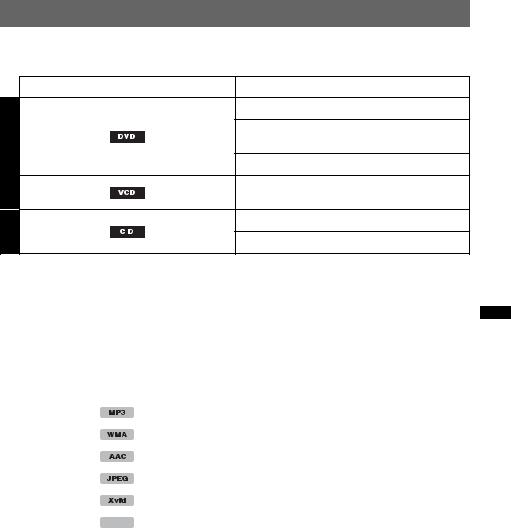
Playable discs and symbols used in these Operating Instructions
This unit can play various video/audio discs.
The following chart helps you to check if a disc is supported by this unit, as well as what functions are available for a given disc type.
AUDIO VIDEO
Disc symbol in manual |
Disc format |
|
|
DVD VIDEO
DVD-R*1/DVD-R DL*1/DVD-RW*1
(Video mode/VR mode)
DVD+R*1/DVD+R DL*1/DVD+RW*1
Video CD (Ver. 1.0/1.1/2.0)
Audio CD
CD-ROM*2/CD-R*2/CD-RW*2
*1 Audio files can also be stored.
*2 Video/image files can also be stored.
Note
“DVD” may be used in these Operating Instructions as a general term for DVD VIDEOs, DVD-Rs/DVD-RWs, and DVD+Rs/DVD+RWs.
The following chart shows the supported file types and their symbols.
Available functions differ depending on the format, regardless of disc type. The format symbols below appear in these Operating Instructions next to the description of functions available for their corresponding file types.
Format symbol in manual |
File type |
|
|
|
MP3 audio file |
|
|
|
WMA audio file |
|
|
|
AAC audio file |
|
|
|
JPEG image file |
|
|
|
Xvid video file |
|
|
MPEG-4 |
MPEG-4 video file |
|
|
Tip
For details on compression formats, see page 61.
Note
Even compatible discs may not be playable on this unit, depending on their recording condition.
11
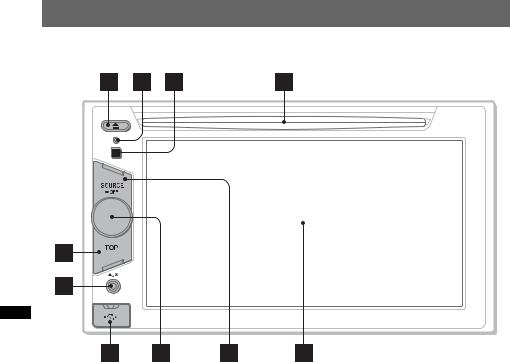
Location and function of controls/terminals
Main unit
For details, see the pages listed below.
A Z (Eject) button page 17
B Reset button page 14
C Receptor for the remote commander
D Disc slot page 17
ETOP button
For XAV-62BT
Press to open the top menu.
For XAV-622
Press to open the source list.
F Front AUX terminal page 57
GUSB terminal
Remove the cap to connect a USB device.
H Volume control dial
ISOURCE/OFF button*2
Press to turn on the power/change the source: “Tuner” (Radio), “Disc,” “iPod/USB,” “AUX” (Auxiliary equipment), “BT Audio” (Bluetooth Audio)*1.
Press and hold for 1 second to exit the source.
Press and hold for more than 2 seconds to turn off.
J Display/touch panel
*1 “BT Audio” (Bluetooth Audio) is available only on XAV-62BT.
*2 If an HD Radio tuner or SAT tuner is connected and (SOURCE/OFF) is pressed, the connected device (“HD Radio,” “XM,” or “Sirius”) will appear on the display.
If multiple devices are connected, “External” will appear on the display.
12

Screen displays
When no source is selected:
1
Source List |
A“Source List” key
Touch to open the source list.
2 B “Top” key
|
XAV-62BT |
|
Touch to open the top menu. |
Top |
XAV-622 |
|
Touch to open the source list. |
C Clock page 53, 56
D  (Close) key
(Close) key
Touch to close the menu.
E “ATT” (Attenuate) key*1
10:00 AM
Touch to attenuate the sound. To cancel, touch again.
3
Top menu (XAV-62BT only):
F  (Setting) key
(Setting) key
Touch to open the setting menu.
4 |
5 |
6 7 |
G |
|
ATT |
M.OFF |
|
|
|
|
H |
|
AV Source |
BT Phone |
I |
|
|
|
|
|
|
|
J |
|
8 |
9 |
|
Source list:
4 5 |
6 qa |
K |
|
|
“M.OFF” (Monitor off) key
Touch to turn off the monitor and the button illumination. To turn back on, touch anywhere on the display.
“AV Source” key*2
Touch to open the source list.
“BT Phone” key*2
Touch to enter Bluetooth Phone mode.
Source select keys*3
Touch to change the source: “Tuner” (Radio), “Disc,” “AUX” (Auxiliary equipment), “iPod/USB,” “SensMe™,” “BT Audio” (Bluetooth Audio)*4.
“Top” key/“M.OFF” key
|
ATT |
|
Top |
|
|
|
|
|
*1 |
Tuner |
Disc |
AUX |
iPod/USB |
*2 |
|
|
|
|
*3 |
|
SensMe™ |
BT Audio |
External |
|
|
|
|
|
*4 |
|
|
0 *4 |
|
|
This key varies based on the model. XAV-62BT: “Top” key
XAV-622: “M.OFF” key
See above for the function of each key.
Appears only when a source is selected. Available on XAV-62BT only.
If an HD Radio tuner or SAT tuner is connected and (SOURCE/OFF) is pressed, the connected device (“HD Radio,” “XM,” or “Sirius”) will appear on the display.
If multiple devices are connected, “External” will appear on the display.
“BT Audio” appears on XAV-62BT only.
13

Getting Started
Resetting the unit
Before operating the unit for the first time, or after replacing the car battery or changing the connections, you must reset the unit.
Press the reset button (page 12) with a pointed object, such as a ballpoint pen.
Note
Pressing the reset button will erase the clock setting and some stored contents.
Performing initial settings
After resetting, the display for the initial settings appears.
Initial Setting
Rear/Sub Out |
Rear / Sub |
|
|
Listening Position |
Front L / Front R |
|
|
Language |
English |
|
|
OK
1Touch “Rear/Sub Out” to set the subwoofer connection status.
If a subwoofer is connected, select “Sub.” If a power amplifier is connected, select “Rear.”
If neither a subwoofer or power amplifier is connected, you can select either “Sub” or “Rear.”
2Touch “Listening Position” to set the listening position.
Set to “Front L” if your listening position is front left, or “Front R” if front right.
3Touch “Language” to set the display language.
Touch repeatedly until the desired language (English/Spanish/Russian) appears.
4Touch “OK.”
The setting is complete.
This setting can then be further configured in the setting menu.
•For details on setting the subwoofer connection status, see page 52.
•For details on setting the listening position, see “Optimizing sound for the listening position — Intelligent Time Alignment” on page 44.
•For details on setting the display language, see page 49.
14
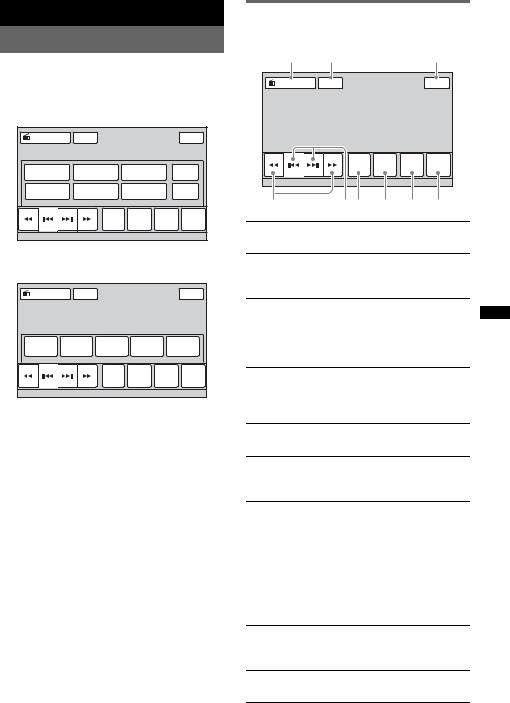
Radio
Listening to the radio
1Touch “Source List,” then “Tuner.”
(For XAV-62BT only: From the top menu, touch “AV Source,” then “Tuner.”)
The radio reception display appears, and the preset list is displayed automatically.
Source List |
ATT |
|
|
Top |
P1 |
P2 |
P3 |
|
BTM |
|
|
|
|
|
P4 |
P5 |
P6 |
|
Memory |
|
|
|
|
|
|
|
Receive |
Preset |
PTY |
|
|
Band |
List |
List |
|
|
Menu |
2Touch “Band.”
The band list appears.
Source List |
ATT |
|
|
|
Top |
FM1 |
FM2 |
FM3 |
AM1 |
|
AM2 |
|
|
Band |
Receive |
Preset |
PTY |
|
|
Menu |
List |
List |
|
|
|
|
3Touch the desired band (“FM1,” “FM2,” “FM3,” “AM1,” or “AM2”).
Touch “Band” again to close the band list.
4Perform tuning.
To tune automatically
Touch ./>.
Scanning stops when the unit receives a station. Repeat this procedure until the desired station is received.
To tune manually
Touch m/M repeatedly until the desired frequency is received.
To skip frequencies continuously, touch and hold m/M.
Reception controls
Touch the display if the reception controls are not displayed.
1 |
2 |
|
|
3 |
Source List |
ATT |
|
|
Top |
|
Band |
Receive |
Preset |
PTY |
|
Menu |
List |
List |
|
|
|
|||
4 |
56 |
7 |
8 |
9 |
1“Source List”
Touch to open the source list. (page 13)
2“ATT”
Touch to attenuate the sound. To cancel, touch again.
3“Top”
XAV-62BT
Touch to open the top menu. (page 13)
XAV-622
Touch to open the source list. (page 13)
4m/M
Touch to tune manually.
Touch and hold to continuously skip frequencies.
5./>
Touch to tune automatically.
6“Band”
Touch to open the band list and change the band.
7“Receive Menu”
Touch to open the receive menu, which contains the following items.
•“Mono”: Touch to activate monaural mode if FM reception is poor. To restore stereo reception, select “OFF.”
•“Local”: Touch to tune only to stations with strong signals. To tune normally, select “OFF.”
8“Preset List”
Touch to list up stored stations, or store stations. (page 16)
9“PTY List”
Touch to open the PTY list. (page 17)
15
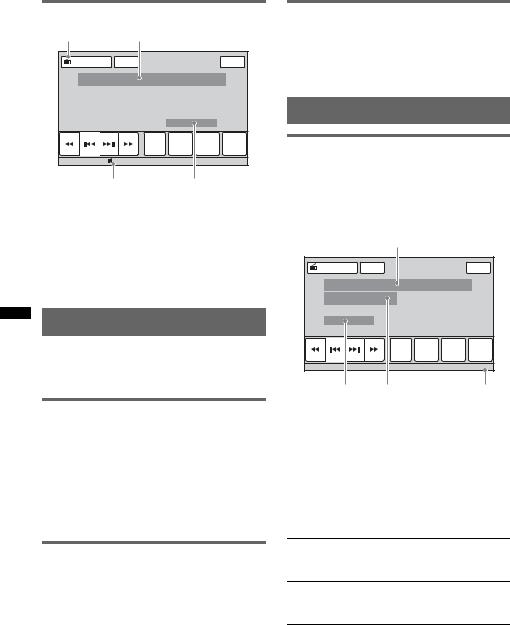
Reception indications
A |
|
B |
|
|
Source List |
ATT |
|
|
Top |
|
|
Receive |
Preset |
PTY |
|
|
Band |
List |
List |
|
|
Menu |
||
|
15 |
|
|
|
|
C |
D |
|
|
A Current source icon*1
B Band name, preset number*2, frequency/ status
C Volume level*3
D Setting status (EQ7, RBE)
*1 Appears only when the controls are displayed.
*2 Appears only when a preset station is received.
*3 When ATT is activated,  appears.
appears.
Storing and receiving stations
Caution
When tuning to stations while driving, use Best Tuning Memory (BTM) to prevent an accident.
Storing automatically — BTM
1Touch “Source List,” then “Tuner.”
To change the band, touch “Band,” then select the desired band (“FM1,” “FM2,” “FM3,” “AM1,” or “AM2”).
2Touch “Preset List,” then “BTM.”
The unit stores the first six available stations in the preset list (“P1” to “P6”).
A beep sounds when the setting is stored.
Storing manually
1While receiving the station that you want to store, touch “Preset List.”
2Touch “Memory,” then touch a number in the list (“P1” to “P6”).
The number and the confirmation display appear.
3Touch “Yes.”
The station is stored.
Note
If you try to store another station to the same number, the previously stored station will be replaced.
Receiving stored stations
1Select the band, then touch “Preset List.”
2Touch the desired number (“P1” to “P6”).
RDS
Overview
FM stations with Radio Data System (RDS) service send inaudible digital information along with the regular radio program signal.
Display items
|
A |
|
|
Source List |
ATT |
|
Top |
|
Receive |
Preset |
PTY |
|
Band |
List |
List |
|
Menu |
||
|
|
|
10:00 AM |
B |
C |
|
D |
A Band name, preset number, frequency B Stereo*1, RDS*2
C Program service name D Clock
*1 During FM reception.
*2 During RDS reception.
RDS services
This unit automatically provides RDS services as follows:
PTY (Program Types)
Displays the currently received program type. Also searches for a designated program type.
CT (Clock Time)
The CT data from the RDS transmission sets the clock.
Notes
•Depending on the country/region, not all RDS functions may be available.
•RDS will not work if the signal strength is too weak, or if the station you are tuned to is not transmitting RDS data.
16

Selecting PTY
1During FM reception, touch “PTY List.”
The PTY list appears if the station is transmitting PTY data.
To scroll the list, touch v/V.
2Touch the desired program type.
The unit searches for a station broadcasting the selected program type.
To close the PTY list, touch “PTY List.”
Type of programs
“News” (News), “Information”
(Information), “Sports” (Sports), “Talk”
(Talk), “Rock” (Rock), “Classic Rock”
(Classic Rock), “Adult Hits” (Adult Hits), “Soft Rock” (Soft Rock), “Top 40” (Top 40), “Country” (Country), “Oldies” (Oldies), “Soft” (Soft), “Nostalgia” (Nostalgia), “Jazz” (Jazz), “Classical” (Classical), “Rhythm and Blues” (Rhythm and Blues), “Soft R & B” (Soft Rhythm and Blues), “Foreign Language” (Foreign Language), “Religious Music” (Religious Music), “Religious Talk” (Religious Talk),
“Personality” (Personality), “Public”
(Public), “College” (College), “Weather” (Weather)
Notes
•You cannot use this function in countries/regions where no PTY data is available.
•You may receive a different radio program from the one you select.
Setting CT
1 Set “CT” to “ON” in setting (page 49).
Notes
•The CT function may not work even though an RDS station is being received.
•There may be a difference between the time set by the CT function and the actual time.
Discs
Playing discs
Depending on the disc, some operations may be different or restricted.
Refer to the operating instructions supplied with your disc.
1Insert the disc (label side up).
Playback starts automatically.
If the DVD menu appears
Touch the item in the DVD menu.
You can also use the menu control panel, which can be displayed by touching outside of the DVD menu. Touch b/v/V/B to move the cursor, then touch “Enter” to confirm.
If the menu control panel does not appear by touching the display, use the remote commander (not supplied).
About the DVD menu
A DVD is divided into several sections, which make up a picture or music feature. These sections are called “titles.” When you play a DVD that contains several titles, you can select a desired title using the DVD’s top menu. For DVDs that allow you to select items such as subtitle/sound language(s), select these items using the DVD menu.
If the disc contains JPEG files
The slide show starts automatically.
To stop playback
Press and hold (SOURCE/OFF) for 1 second.
Note
Discs in DTS format are not supported. The sound is not output if the DTS format is selected.
To eject the disc
1 Press Z on the main unit.
17
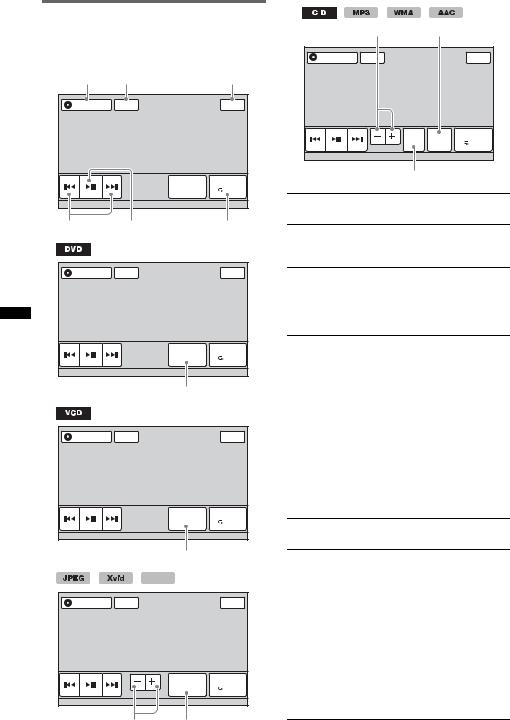
Playback controls
Touch the display if the playback controls are not displayed.
Common to all discs/formats
1 |
2 |
3 |
Source List |
ATT |
Top |
|
DVD |
Play Menu |
|
Control |
SHUF |
4 |
5 |
6 |
Source List |
ATT |
Top |
DVD |
Play Menu |
Control |
SHUF |
|
|
7 |
Source List |
ATT |
Top |
|
|
Play Menu |
|
|
PBC Panel |
|
|
SHUF |
|
|
8 |
|
|
MPEG-4 |
Source List |
ATT |
Top |
List
Play Menu
SHUF
Album
18 |
9 |
q; |
|
|
9 |
q; |
Source List |
ATT |
Top |
|
ZAP |
Play Menu |
|
List |
|
|
Album |
SHUF |
|
|
|
|
qa |
|
1“Source List”
Touch to open the source list. (page 13)
2“ATT”
Touch to attenuate the sound. To cancel, touch again.
3“Top”
XAV-62BT
Touch to open the top menu. (page 13)
XAV-622
Touch to open the source list. (page 13)
4./>
Touch to skip a chapter/track/scene/ image/file.
Touch and hold momentarily to reverse/ fast-forward the video; and then repeatedly to switch the speed (× 2 t × 12 t × 120 t × 2 …)*1. To cancel, touch u.
Touch and hold to reverse/fast-forward the audio track.
During pause, touch and hold down > to play the video in slow motion. To cancel, release the key.
5u
Touch to pause/resume play after pause.
6“Play Menu”
Touch to open the play menu, which contains the following items.
•“Repeat”/“Shuffle” (page 22)
•“Dolby D Level” (DVD VIDEO playback only) (page 21)
•“Stereo” (VCD/CD/MP3/WMA/AAC playback only) (page 21)
•“Image Turn” (JPEG playback only): Touch to rotate an image left/right.
•“Audio” (Xvid/MPEG-4 playback only) (page 21)

7“DVD Control”
Touch to open the DVD control menu, which contains the following items.
•“Audio”: Touch repeatedly to select the audio language/format. (page 20)*2
•“Subtitle”: Touch repeatedly to turn off/select the subtitle language.*2*3
•“Angle”: Touch repeatedly to change the viewing angle.*2
•“Top Menu”: Touch to open the top menu on the DVD.*2
•“Menu”: Touch to open the menu on the disc.*2
8“PBC Panel”
Touch to display the control panel for the PBC menu. (page 20)
9“Album” –/+
Touch to skip an MP3/WMA/AAC/JPEG/ Xvid/MPEG-4 album (folder).
0“List”
Touch to list up tracks/images/video files. (page 31)
qa “ZAP”
Touch to enter ZAPPIN mode. (page 31)
*1 The speed depends on the format or the recording method.
*2 Availability depends on the disc.
*3 When the 4-digit input prompt appears, input the language code (page 71) for the desired language.
Note
If the disc contains multiple file types, only the selected file type (audio/video/image) can be played. For details on how to select the file type, see “Selecting a file type” on page 31.
Notes on JPEG playback
•If a large-sized image is rotated, it may take longer to display.
•Progressive JPEG files cannot be displayed.
Playback indications
Touch the display if the indications are not displayed.
For audio discs, some indications are always displayed during playback.
|
|
MPEG-4 |
A |
|
|
Source List |
ATT |
Top |
|
DVD |
Play Menu |
|
Control |
SHUF |
15 |
|
|
B |
C |
|
D |
E |
F |
Source List |
ATT |
Top |
ZAP |
Play Menu |
List |
|
Album |
SHUF |
|
G
A Current source icon
B Volume level*1
CFormat, playback status, elapsed playback time*2, chapter/title/album (folder)/track number*3*4, audio format*5, setting status
(CSO, EQ7, RBE)
D Playback status, elapsed playback time*2 E Track name, album name, artist name F Album artwork display*6
GFormat, track number, album number*7, setting status (CSO, EQ7, RBE)
*1 |
When ATT is activated, |
|
appears. |
|
|||
*2 |
During JPEG playback or VCD playback with PBC |
||
|
functions, no indication appears. |
||
*3 |
Indications differ depending on the disc/format. |
||
*4 |
When playing a VCD with PBC functions |
||
|
(page 20), no indication appears. |
||
*5 |
DVD only. |
|
|
*6 |
The recommended size is from 240 × 240 to 960 × |
||
|
960 pixels. |
|
|
*7 |
MP3/WMA/AAC only. |
|
|
19

Using PBC (playback control) functions
The PBC menu interactively assists with operations while a PBC-compatible VCD is played.
1Start playing a PBC-compatible VCD.
The PBC menu appears.
2Touch “PBC Panel.”
The menu control panel appears.
3Touch the number keys to select the desired item, then touch “Enter.”
4Follow the instructions in the menu for interactive operations.
To return to the previous display, press O. To hide the controls, touch “Close.”
Playing without PBC functions
1While no source is selected, touch “Source List,” then  .
.
2Touch “Visual.”
The visual setting menu appears.
3Touch v/V to scroll, then touch “Video
CD PBC” to set to “OFF.”
4Start playing a VCD.
The PBC menu does not appear during playback.
Notes
•The items on the menu, and operation procedures differ depending on the disc.
•During PBC playback, the track number, playback item, etc., do not appear on the playback display.
•Resume playback is unavailable during playback without PBC.
Configuring audio settings
Note
Discs in DTS format are not supported. The sound is not output if the DTS format is selected.
Changing the audio language/ format 
The audio language can be changed if the disc is recorded with multilingual tracks. You can also change the audio format when playing a disc recorded in multiple audio formats (e.g., Dolby Digital).
1During playback, touch “DVD Control.”
2Touch “Audio” repeatedly until the desired audio language/format appears.
Audio language
Source List |
ATT |
|
|
Top |
Audio |
1: English |
|
|
Dolby D 3/2.1 |
Audio |
Subtitle |
Angle |
Top Menu |
Menu |
|
|
|
DVD |
Play Menu |
|
|
|
Control |
SHUF |
Audio format/channel numbers*
The audio language switches among the available languages.
When the 4-digit input prompt appears, input the language code (page 71) for the desired language.
When the same language is displayed two or more times, the disc is recorded in multiple audio formats.
*The format name and channel numbers appear as follows:
Example: Dolby Digital 5.1 ch
Rear channel × 2
Dolby D 3 / 2 . 1
Front channel × 2 + |
LFE channel × 1 |
Center channel × 1 |
|
To close the DVD control menu, touch “DVD Control.”
20

Changing the audio channel
MPEG-4
When playing a VCD/CD/MP3/WMA/AAC/ Xvid/MPEG-4, you can listen to both the right and left channel, only the right channel, or only the left channel via both the right and left speakers.
The options are indicated below.
“2-Ch”: Standard stereo sound (default) “L-Ch”: Left channel sound (monaural) “R-Ch”: Right channel sound (monaural)
For VCD/CD/MP3/WMA/AAC
1During playback, touch “Play Menu,” then “Stereo” repeatedly until the desired audio channel appears.
For Xvid/MPEG-4
1During playback, touch “Play Menu,” then “Audio” repeatedly until the desired audio channel appears.
To close the play menu, touch “Play Menu.”
Note
You may not be able to change the audio setting depending on the disc.
Tip
Operation via the remote commander (not supplied) by pressing (AUDIO) repeatedly is also available.
Locking discs
— Parental control
 *
*
* Excluding DVD-R/DVD-R DL/DVD-RW in VR mode.
You can lock a disc, or set playback restrictions according to a predetermined level such as viewer age. Restricted scenes can be blocked or replaced with different scenes when a parental control-compatible DVD is played.
Activating parental control
1While no source is selected, touch “Source List,” then  .
.
2Touch “Visual.”
The visual setting menu appears.
3Touch v/V to scroll, then touch “DVD
Parental Control.”
The password setting display appears.
4Touch the number keys to enter your password, then touch “OK.”
5To confirm, touch the number keys to reenter your password, then touch “OK.”
The setting is complete.
To delete an entered number, touch “Clear.”
To return to the previous display, touch “Back.”
Adjusting the audio output level
— Dolby D level 
You can adjust the audio output level for a DVD recorded in Dolby Digital format, to reduce the volume level differences between discs.
1During playback, touch “Play Menu.”
2Touch the “Adjust” box to set to “ON.”
3Touch –/+ repeatedly to adjust the output level.
The output level is adjustable in single steps, between –10 and +10.
To close the play menu, touch “Play Menu.”
Deactivating parental control
1Follow steps 1 to 3 above.
The parental unlock display appears.
2Touch the number keys to enter your current password.
“Parental Unlocked” appears, and the parental control is deactivated.
Changing the password
Deactivate the parental control, then activate again using the new password.
21
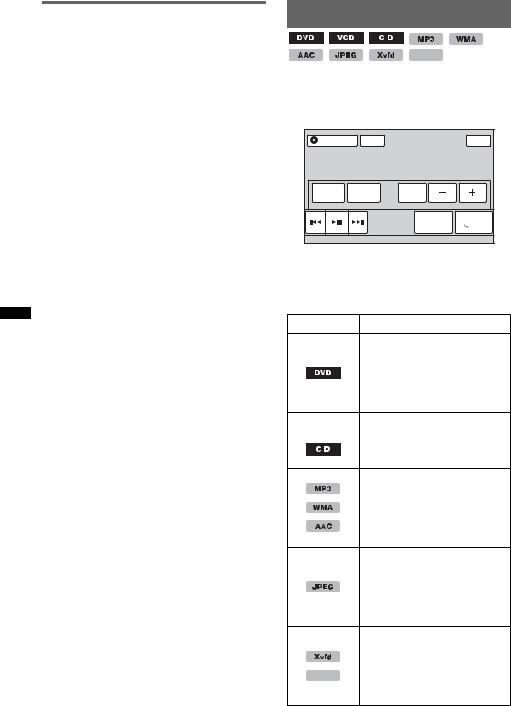
Changing the area and its movie rating level
The restriction levels can be set based on the area and its movie ratings.
1While no source is selected, touch “Source List,” then  .
.
2Touch “Visual.”
The visual setting menu appears.
3Touch v/V to scroll, then touch “DVD
Parental Area.”
When parental control is already activated, the display to enter your password appears. To change the setting, enter your password. The options appear.
4Touch the desired area to apply its movie ratings.
When you select “Other,” enter the area code by selecting from “Area code list” on page 71 using the number keys.
5Touch “DVD Parental Rating.”
The options appear.
The lower the number, the stricter the restriction level.
6Touch the desired rating.
The setting is complete.
To return to the previous display, touch “Back.”
Repeat and shuffle play
MPEG-4
1During playback, touch “Play Menu,” then the “Repeat” or “Shuffle” box repeatedly until the desired option appears.
Source List |
ATT |
|
|
Top |
Chapter |
OFF |
ON |
|
|
Repeat |
Shuffle |
Adjust |
Dolby D Level 0 |
|
|
|
|
DVD |
Play Menu |
|
|
|
Control |
SHUF |
Repeat or shuffle play starts.
To close the play menu, touch “Play Menu.”
The repeat options and switching order of each disc/format are indicated below.
Disc/format Options
“OFF”: Returns to normal play mode.
“Chapter”: Repeats the current chapter.
“Title”: Repeats the current title.
“OFF”: Returns to normal play  *1 mode.
*1 mode.
“Track”: Repeats the current track.
“OFF”: Returns to normal play mode.
“Track”: Repeats the current track.
“Album”: Repeats the current album (folder).
“OFF”: Returns to normal play mode.
“Image”: Repeats the current image.
“Album”: Repeats the current album.
“OFF”: Returns to normal play mode.
|
“Movie”: Repeats the current |
MPEG-4 |
video file. |
“Album”: Repeats the current album (folder).
22

The shuffle options and switching order of each disc/format are indicated below.
Disc/format |
Options |
||||
|
|
|
|
|
“OFF”: Returns to normal play |
|
|
|
*2 |
mode. |
|
|
|
||||
|
|
|
|
|
“Title”: Plays chapters in the |
|
|
|
|
|
|
|
|
|
|
|
current title in random order. |
|
|
|
|
|
|
|
|
|
*1 |
“OFF”: Returns to normal play |
|
|
|
||||
|
|
|
|
|
mode. |
|
|
|
|
|
|
|
|
|
|
|
“Disc”: Plays tracks in the |
|
|
|
|
|
|
|
|
|
|
|
current disc in random order. |
|
|
|
|
|
|
|
|
|
|
|
“OFF”: Returns to normal play |
|
|
|
|
|
mode. |
|
|
|
|
|
“Album”: Plays tracks/images/ |
|
|
|
|
|
video files in the current album |
|
|
|
|
|
(folder) in random order. |
MPEG-4
*1 Available only when playing a version 1.0/1.1 VCD, or a version 2.0 VCD without PBC functions.
*2 Excluding a DVD-R/DVD-R DL/DVD-RW in VR mode.
Direct search play
MPEG-4
You can directly locate a desired point by specifying the title number, chapter number, etc.
1During playback, press the number buttons on the remote commander (not supplied) to enter an item (track, title, etc.) number, then press (ENTER).
Playback starts from the beginning of the selected point.
The search items for a disc/format are as follows:
DVD: Title or chapter*1
VCD*2/CD/MP3/WMA/AAC: Track JPEG: Image
Xvid/MPEG-4: Movie
*1 The search item depends on the setting.
*2 Available only when playing a VCD without PBC functions.
Setting the search item (DVD only)
You can set the search item (title or chapter) for DVD playback.
1Touch “Source List,” then touch  .
.
2Touch “Visual.”
The visual setting menu appears.
3Touch v/V to scroll, then touch “DVD
Direct Search” to set to “Chapter” or “Title.”
The setting is complete.
To return to the previous display, touch “Back.”
23

USB Device Operations
For details on the compatibility of your USB device, visit the support site.
Support site
http://esupport.sony.com
http://www.sony.com/mobileAV
•MSC (Mass Storage Class) and MTP (Media Transfer Protocol) type USB devices compliant with the USB standard can be used.
•Compatible codecs are MP3 (.mp3), WMA (.wma), AAC (.m4a), JPEG (.jpg), Xvid (.avi), and MPEG-4 (.mp4).
•Backup of data in a USB device is recommended.
Notes
•Connect the USB device after starting the engine. Depending on the USB device, malfunction or damage may occur if it is connected before starting the engine.
•A large-sized file may take time to start playing.
Playing from a USB device
1Remove the cap from the USB connector, and connect the USB device to the USB connector.
Playback starts automatically.
If a USB device is already connected, touch “Source List,” then “iPod/USB” to start playback.
For details on the location of the USB connector, see “Location and function of controls/terminals” (page 12).
About the playback controls and indications
You can control USB playback in the same way as disc playback. For details, see “Playback controls” on page 18.
For details on playback indications, see “Playback indications” on page 19.
To stop playback
Press and hold (SOURCE/OFF) for 1 second.
To disconnect the USB device
Stop playback, then disconnect.
Do not disconnect during playback, as data in the USB device may be damaged.
Notes on use
•Do not use USB devices so large or heavy that they may fall down due to vibration, or cause a loose connection.
•Do not leave a USB device in a parked car, as malfunction may result.
•This unit cannot recognize USB devices via a USB hub.
•Be sure to use the USB cable supplied with the device if a cable is needed when making a USB connection.
Notes on playback
•If a USB device contains multiple file types, only the selected file type (audio/video/image) can be played. For details on how to select the file type, see “Selecting a file type” on page 31.
•Displayed indications will differ, depending on the USB device, recorded format and settings. For details, visit the support site.
•The maximum number of displayable data is as follows:
–folders (albums): 256
–files (tracks): 2,000
•It may take time for playback to begin, depending on the amount of recorded data.
•DRM (Digital Rights Management) files may not be played.
•During playback or reverse/fast-forward of a VBR (Variable Bit Rate) MP3/WMA/AAC file, elapsed playing time may not display accurately.
•Playback of a lossless compression file is not supported.
Repeat and shuffle play
1During playback, touch “Play Menu,” then the “Repeat” or “Shuffle” box repeatedly until the desired option appears.
Repeat or shuffle play starts.
The repeat options are as follows:
“OFF”: Returns to normal play mode.
“Track”/“Image”/“Movie”*1: Repeats the current track/image/video file.
“Album”: Repeats the current album (folder). “Drive”*2: Repeats the current drive.
The shuffle options are as follows:
“OFF”: Returns to normal play mode. “Album”: Plays tracks/images/video files in the current album (folder) in random order.
*1 Options depend on the file type.
*2 When two or more drives exist on the USB device.
To close the play menu, touch “Play Menu.”
24

Enjoying music according to your mood — SensMe™
Sony’s unique “SensMe™ channels” and “SensMe™ mood” features automatically group tracks by channel or mood, and allow you to enjoy music intuitively.
Before using the SensMe™ function
The following is the basic procedure required to enjoy the SensMe™ function on the unit.
1Installing “SensMe™ Setup” and “Content Transfer” to your computer
First install “SensMe™ Setup” and “Content Transfer” from the supplied CD-ROM.
SensMe™ Content
Setup Transfer
2Registering a USB device using “SensMe™ Setup”
Connect a USB device to your computer, and perform registration using “SensMe™ Setup” to enable the SensMe™ function on this unit.
SensMe™
Setup
Tip
Registration can be performed either along with the installation procedure or after installation.
3Transferring tracks to the USB device using “Content Transfer”
In order to group tracks by channel or mood, track sound patterns need to be analyzed by 12 TONE ANALYSIS, which is loaded with “Content Transfer.”
With the USB device connected to your computer, drag and drop tracks from Windows Explorer or iTunes, etc., to “Content Transfer.”
Both analysis and transfer of tracks will be performed by “Content Transfer.”
Content |
Transfer |
4Connecting the USB device and enjoying the SensMe™ function on the unit
Connect the set up USB device. You can then enjoy “SensMe™ channels” or “SensMe™ mood” on this unit.
SensMe™
Installing “SensMe™ Setup” and “Content Transfer” on your computer
Use of the supplied software (“SensMe™ Setup” and “Content Transfer”) is required to enable the SensMe™ function on this unit.
Install the software to your computer from the supplied CD-ROM.
1Insert the supplied CD-ROM into your computer.
The Installation Wizard runs automatically.
2Follow the on-screen instructions to complete the installation.
25
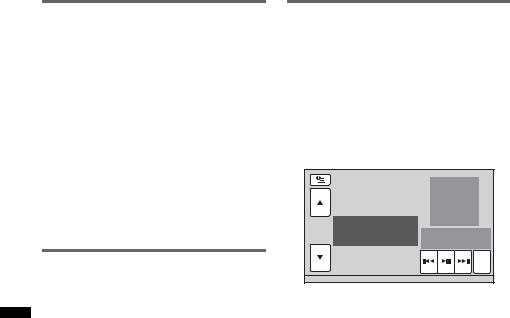
Registering a USB device using “SensMe™ Setup”
USB device registration is required to enable the SensMe™ function on the unit.
If registration is not performed along with the installation procedure, follow the steps below.
1Start “SensMe™ Setup” on your computer.
2Connect a USB device to your computer.
3Complete registration following the on-screen instructions.
Tip
If you connect a registered USB device containing analyzed tracks, the USB device can be unregistered again.
Transferring tracks to the USB device using “Content Transfer”
To enable the SensMe™ function on this unit, tracks need to be analyzed and transferred to the registered USB device using “Content Transfer.”
1Connect the registered USB device to your computer.
For “WALKMAN,” connect via MTP mode. For USB devices other than “WALKMAN,” connect via MSC mode.
“Content Transfer” starts automatically. If a message appears, follow the on-screen instructions to proceed.
2Drag and drop tracks from Windows Explorer or iTunes, etc., to “Content Transfer.”
The analysis and transfer of tracks starts.
For details on operations, refer to the Help of “Content Transfer.”
Note
The track analysis by 12 TONE ANALYSIS may take time, depending on the computer environment.
Tip
Not only audio files but also image or video files can be transferred using “Content Transfer.” For details, refer to the Help of “Content Transfer.”
Playing tracks in channels
— SensMe™ channels
“SensMe™ channels” automatically group tracks into channels by their tunes. You can select and play a channel that fits your mood, activity, etc.
1Connect a USB device set up for the SensMe™ function.
2Touch “Source List,” then “SensMe™.”
3Touch “channels.”
The channel list appears.
Shuffle All
Energetic
Relax |
ZAP |
4Touch v/V to scroll the channel list.
Playback of the first track in the current channel starts from the track’s most melodic or rhythmical section*.
*May not be detected correctly.
5Touch the desired channel.
Playback of tracks in the selected channel starts.
Notes
•Depending on the track, it may not be detected correctly or may be grouped in a channel not suited to the track’s mood.
•If the connected USB device contains many tracks, it may take time for “SensMe™ channels” to start, due to data reading.
Tip
Tracks are played in random order. The order will vary with each channel selection.
26

Channel list
x Recommended, Shuffle All
“Morning” (5:00 AM – 9:59 AM)
“Daytime” (10:00 AM – 3:59 PM)
“Evening” (4:00 PM – 6:59 PM)
“Night” (7:00 PM – 11:59 PM) “Midnight” (12:00 AM – 4:59 AM)
Plays tracks recommended for each time of day. Set the clock (page 56) for the channel to be displayed accurately.
“Shuffle All”: Plays all analyzed tracks in random order.
x Basic channels
Plays tracks according to the music type.
“Energetic”: High-spirit tracks.
“Relax”: Calm tracks.
“Mellow”: Mellow, melancholy tracks.
“Upbeat”: Happy tracks to improve your mood.
“Emotional”: Ballad tracks.
“Lounge”: Lounge tracks.
“Dance”: Rhythm and rap, rhythm and blues tracks.
“Extreme”: Intense rock tracks.
x In-car channels
Plays tracks that are suitable while driving.
“Freeway”: Speedy, high-spirit tracks.
“Chillout Drive”: Intoned, healing ballad tracks.
“Weekend Trip”: Delightful, bright and happy tracks.
“Midnight Cruise”: Jazz or piano-featured tracks with a mature mood.
“Party Ride”: Up-tempo and lively tracks.
“Morning Commute”: Bright and breezy tracks.
“Goin’ Home”: Warm and relaxing tracks.
“SensMe™ channels” playback controls and indications
A B C D E
Shuffle All |
Energetic
Relax |
ZAP |
F G H
ATo display the control keys: “Source List,” “ATT,” “Top.” (page 18)
B To scroll the list and select another channel. C Indicates the current channel.
D Indicates the album artwork display*1.
EIndicates the elapsed playback time, track name and artist name.
F To pause/resume play after pause. G To skip a track.
HTo enter ZAPPIN mode. (page 31) During ZAPPIN playback of “SensMe™ channels,” the most melodic or rhythmical sections*2 of the tracks are played.
*1 The recommended size is from 240 × 240 to 960 × 960 pixels.
*2 May not be detected correctly.
27

Playing tracks in mood maps
— SensMe™ mood
“SensMe™ mood” distributes tracks as dots on a two-axis mood map, based on the characteristics of the individual tracks.
By touching the point on the map according to your mood, a circle appears around the touched point, and the tracks inside the circle are played.
1Connect a USB device set up for the SensMe™ function.
2Touch “Source List,” then “SensMe™.”
3Touch “mood.”
The two-axis mood map appears.
|
Circle |
|
Fast |
Mood |
|
Type |
|
Sad |
Happy |
Style |
|
Time |
ZAP |
|
Slow |
Dots representing tracks
4Touch the desired point on the map.
A circle appears around the touched point, and playback of tracks inside the circle starts. Playback of the first track starts from its most melodic or rhythmical section*.
*May not be detected correctly.
Notes
•Only the 200 most recently transferred tracks using “Content Transfer” are mapped.
•Depending on the track, it may not be detected correctly or may be mapped in a position not suited to the track’s mood.
•If the connected USB device contains many tracks, it may take time for “SensMe™ mood” to start, due to data reading.
Tips
•In the mood map, the currently played track is indicated as a green dot.
•Tracks are played from the circle’s center outward.
“SensMe™ mood” playback controls and indications
A |
B |
C |
D |
E |
|
|
Fast |
|
|
Mood |
|
|
|
|
Type |
|
|
|
|
|
Sad |
Happy |
|
|
Style |
|
|
|
|
Time |
|
Slow |
|
ZAP |
|
|
|
|
|
F |
|
|
G |
H I |
ATo display the control keys: “Source List,” “ATT,” “Top.” (page 18)
B To move the circle and regroup tracks.
CTo change the size of the circle: small, medium, or large.
D Indicates the album artwork display*1.
EIndicates the elapsed playback time, track name and artist name.
F To change parameters on the horizontal axis. G To skip a track.
H To pause/resume play after pause.
ITo enter ZAPPIN mode. (page 31) During ZAPPIN playback of “SensMe™ mood,” the most melodic or rhythmical sections*2 of the tracks are played.
*1 The recommended size is from 240 × 240 to 960 × 960 pixels.
*2 May not be detected correctly.
Changing parameters on the horizontal axis
In the mood map, you can change parameters on the horizontal axis. Tracks are remapped according to the characteristics of the parameters.
Do this |
To change parameters to |
|
|
Touch “Mood” “Sad” – “Happy”
Touch “Type” “Acoustic” – “Electronic”
Touch “Style” “Soft” – “Hard”
Touch “Time” “Morning” – “Midnight”
28

iPod Operations
For details on the compatibility of your iPod, see “About iPod” on page 62 or visit the support site.
Support site
http://esupport.sony.com
http://www.sony.com/mobileAV
In these Operating Instructions, “iPod” is used as a general reference for the iPod functions on the iPod and iPhone, unless otherwise specified by the text or illustrations.
Playing an iPod
1Reduce the volume on this unit.
2Remove the cap from the USB connector, and connect the iPod to the USB connector.
Use of the optional USB connection cable RC-202IPV is recommended.*1
While the iPod is connected, a device connected to the front AUX terminal becomes unavailable, and “Front AUX” cannot be selected when changing the source.
The following display appears on the iPod screen*2, then playback starts from the item last played.
If an iPod is already connected, to start playback, touch “Source List,” then “iPod/ USB.”
*1 To play videos from an iPod with video, use of the RC-202IPV is required.
*2 May not appear in the case of an iPod touch or iPhone being connected, or when the iPod was last played using passenger control.
3 Adjust the volume on this unit.
About playback controls and indications
You can control iPod playback in the same way as disc playback. For details, see “Playback controls” on page 18.
For details on playback indications, see “Playback indications” on page 19.
To stop playback
Press and hold (SOURCE/OFF) for 1 second.
To disconnect the iPod
Stop playback, then disconnect.
Do not disconnect during playback, as data in the iPod may be damaged.
About resuming mode
When the iPod currently playing is connected to the dock connector, the mode of this unit changes to resuming mode and playback starts in the mode set by the iPod.
In resuming mode, repeat/shuffle play are not available.
Caution for iPhone
When you connect an iPhone via USB, telephone volume is controlled by the iPhone itself. In order to avoid emitting sudden loud sound after a call, do not increase the volume on the unit during a call.
Note
This unit cannot recognize an iPod via a USB hub.
Tips
•When the ignition key is turned to the ACC position with the unit on, the iPod will be recharged.
•If the iPod is disconnected during playback, “USB device is not connected.” appears on the display of the unit.
Setting the play mode
You can set one of the following play modes.
For audio playback
“ALBUM,” “TRACK,” “GENRE,” “PLAYLIST,” “ARTIST,” “MUSIC PODCAST”*
For video playback
“MOVIE,” “RENTAL,” “TV SHOW,” “MUSIC VIDEO,” “VIDEO PLAYLIST,” “VIDEO PODCAST”*
* May not appear depending on iPod setting.
1During playback, touch “List.”
2Touch “MUSIC” or “VIDEO.”
continue to next page t 29

3Touch the desired play mode.
To start playback, touch the desired item(s) in the list.
To scroll the list, touch v/V.
To skip items of the selected play mode
During playback, touch –/+ of the selected play mode.
Repeat and shuffle play
1During playback, touch “Play Menu,” then the “Repeat” or “Shuffle” box repeatedly until the desired option appears.
Repeat or shuffle play starts.
To close the play menu, touch “Play Menu.”
The repeat options are as follows:
For audio playback
“OFF”: Returns to normal play mode. “TRACK”: Repeats the current track.
“ALBUM”/“MUSIC PODCAST”/“ARTIST”/ “PLAYLIST”/“GENRE”*: Repeats the current item of the selected play mode.
For video playback
“OFF”: Returns to normal play mode. “TRACK”: Repeats the current video.
“RENTAL”/“TV SHOW”/“MUSIC VIDEO”/ “VIDEO PLAYLIST”/“VIDEO PODCAST”*: Repeats the current item of the selected play mode.
The shuffle options are as follows:
For audio playback
“OFF”: Returns to normal play mode.
“ALBUM”/“MUSIC PODCAST”/“ARTIST”/ “PLAYLIST”/“GENRE”*: Plays tracks of the selected play mode in random order.
“Device”: Plays all tracks in an iPod in random order.
* Differs depending on the selected play mode.
Note
Displayed options may not conform to actual operation.
Operating an iPod directly
— Passenger control
You can directly operate an iPod connected to this unit.
1During playback, touch “Play Menu,” then the “Passenger Control” box to set to “ON.”
Deactivating the passenger control
Touch the “Passenger Control” box to set to “OFF.”
The play mode changes to resuming mode.
To close the play menu, touch “Play Menu.”
Notes
•To output video to this unit, you need to activate the video output of the iPod.
•The volume can be adjusted only by this unit.
•The repeat setting will be off if the passenger control mode is canceled.
30
